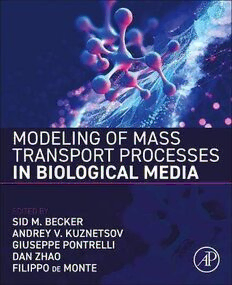
Modeling of Mass Transport Processes in Biological Media PDF
Preview Modeling of Mass Transport Processes in Biological Media
Modeling of Mass Transport Processes in Biological Media This page intentionally left blank Modeling of Mass Transport Processes in Biological Media Edited by Sid Becker Department ofMechanical Engineering, University of Canterbury, Christchurch,New Zealand Andrey V. Kuznetsov Department ofMechanical& AerospaceEngineering, North Carolina State University, Raleigh,NC, United States Filippo de Monte Department ofIndustrial and Information Engineering and Economics, University ofL’Aquila, L’Aquila, Italy Giuseppe Pontrelli Institute ofAppliedMathematics- CNR, Rome, Italy Dan Zhao Department ofMechanical Engineering, University of Canterbury, Christchurch,New Zealand AcademicPressisanimprintofElsevier 125LondonWall,LondonEC2Y5AS,UnitedKingdom 525BStreet,Suite1650,SanDiego,CA92101,UnitedStates 50HampshireStreet,5thFloor,Cambridge,MA02139,UnitedStates TheBoulevard,LangfordLane,Kidlington,OxfordOX51GB,UnitedKingdom Copyright©2022ElsevierInc.Allrightsreserved. Nopartofthispublicationmaybereproducedortransmittedinanyformorbyanymeans,electronicor mechanical,includingphotocopying,recording,oranyinformationstorageandretrievalsystem,without permissioninwritingfromthepublisher.Detailsonhowtoseekpermission,furtherinformationaboutthe Publisher’spermissionspoliciesandourarrangementswithorganizationssuchastheCopyrightClearance CenterandtheCopyrightLicensingAgency,canbefoundatourwebsite:www.elsevier.com/permissions. ThisbookandtheindividualcontributionscontainedinitareprotectedundercopyrightbythePublisher(other thanasmaybenotedherein). Notices Knowledgeandbestpracticeinthisfieldareconstantlychanging.Asnewresearchandexperiencebroadenourunderstanding, changesinresearchmethods,professionalpractices,ormedicaltreatmentmaybecomenecessary. Practitionersandresearchersmustalwaysrelyontheirownexperienceandknowledgeinevaluatingandusinganyinformation, methods,compounds,orexperimentsdescribedherein.Inusingsuchinformationormethodstheyshouldbemindfuloftheir ownsafetyandthesafetyofothers,includingpartiesforwhomtheyhaveaprofessionalresponsibility. Tothefullestextentofthelaw,neitherthePublishernortheauthors,contributors,oreditors,assumeanyliabilityforanyinjury and/ordamagetopersonsorpropertyasamatterofproductsliability,negligenceorotherwise,orfromanyuseoroperationof anymethods,products,instructions,orideascontainedinthematerialherein. ISBN978-0-443-15765-3 ForinformationonallAcademicPresspublications visitourwebsiteathttps://www.elsevier.com/books-and-journals Publisher:MaraConner AcquisitionsEditor:CarrieBolger EditorialProjectManager:EmilyThomson ProductionProjectManager:PrasannaKalyanaraman CoverDesigner:MatthewLimbert TypesetbySTRAIVE,India Contents Contributors.........................................................................................................................................xv Preface................................................................................................................................................xxi CHAPTER 1 Applications of porous media in biological transport modeling......................................................................1 KhalilKhanafer andKambiz Vafai 1.1 Introduction................................................................................................................1 1.2 Applications ofporous media inmodeling inmodeling transport phenomena in arteries................................................................................................1 1.3 Fluid–structure interaction inbiomedical applications..............................................5 1.4 Brain aneurysms.........................................................................................................6 1.5 Magnetic resonance imaging (MRI)........................................................................10 1.6 Concluding remarks.................................................................................................11 References................................................................................................................12 CHAPTER 2 Metabolic consumption of microorganisms.................................17 Peter Vadasz and Alisa S. Vadasz 2.1 Introduction..............................................................................................................17 2.2 Model formulation andmetabolic mass transfer.....................................................20 2.3 Analysis of the equation governing monotonic growth..........................................21 2.3.1 Dimensionlessform ofthe governing equation............................................21 2.3.2 Conditionfor alogarithmic inflectionpoint (LIP)........................................22 2.3.3 Representation of the solutions on phase diagrams and LAG......................23 2.4 Closed form analyticalsolution of the monotonic growth......................................24 2.5 Results and discussion..............................................................................................26 2.6 Conclusions..............................................................................................................27 References................................................................................................................30 Further reading.........................................................................................................32 CHAPTER 3 Numerical simulation of deformability cytometry: Transport of a biological cell through a microfluidic channel.........................33 LucasDanielWittwer,FelixReichel,and Sebastian Aland 3.1 Introduction..............................................................................................................33 3.2 Modelingbiological cells inan RT-DC channel.....................................................35 3.2.1 Themeasurementbuffer asa non-Newtonian fluid......................................35 3.2.2 Thecellasa viscoelastic solid material........................................................36 3.2.3 Boundaryconditions andfluid-solidcoupling..............................................37 3.2.4 Finite-element implementation......................................................................37 v vi Contents 3.3 Hydrodynamicstresseson the cell surface..............................................................39 3.3.1 Fluidflowinthe microfluidic chip...............................................................39 3.3.2 Deformedcells inthe region ofinterest........................................................40 3.4 Cell shapesand cell deformation.............................................................................42 3.4.1 Deformation of highly viscous cells at the outflow......................................46 3.4.2 Inertiaratio andFourier transcriptors............................................................46 3.5 Extraction of the cell viscosity................................................................................47 3.6 Approximationerrorofthe cell volume over the channel......................................50 3.7 Conclusions..............................................................................................................52 Appendix Derivation of the deformation measure from cell contours...................53 Fourier shape descriptors....................................................................................54 Acknowledgments....................................................................................................54 References................................................................................................................54 CHAPTER 4 Computation of organelle age during axonal transport.................57 Ivan A. Kuznetsov and Andrey V. Kuznetsov 4.1 Introduction..............................................................................................................57 4.2 Governing equations.................................................................................................59 4.3 Simulation ofthe DCV concentration inthe axon..................................................62 4.4 Age distributionmodelof DCVs andmeanage ofDCVsin boutons....................63 4.5 Parameter value estimation......................................................................................66 4.5.1 Two groups of parameters.............................................................................66 4.5.2 Estimation ofsaturated concentrations ofDCVs inthe resident state inboutons..............................................................................................67 4.5.3 Estimation ofthe masstransfer coefficients and the saturated concentrations ofDCVsin boutons...............................................................68 4.6 Numerical approach.................................................................................................69 4.7 Results......................................................................................................................69 4.7.1 Assumption about the fate ofDCVs captured into the resident state inboutons..............................................................................................69 4.7.2 Verification ofthe valuestowhichconcentrations converge as t!∞..........................................................................................................69 4.7.3 Investigating sensitivity ofthe mean age ofDCVsinboutons to various parameters.....................................................................................73 4.7.4 Verifying the accuracy ofcomputations........................................................76 4.7.5 Effect ofparameter ε onanterograde andretrograde fluxes between the boutons.....................................................................................................76 4.8 Discussion, modelconstraints,and future directions..............................................77 Acknowledgments....................................................................................................83 References................................................................................................................83 Contents vii CHAPTER 5 Continuum models of drug transport to multiple cell-type population................................................................................87 Filippode Monte, Giampaolo D’Alessandro, SidBecker, and Giuseppe Pontrelli 5.1 Introduction..............................................................................................................88 5.1.1 Transmembrane transport..............................................................................90 5.1.2 Reaction terms andbinding models..............................................................91 5.1.3 Extensionto multiple cell-type populations..................................................93 5.2 Formulation of the problem.....................................................................................95 5.2.1 Concentrations andvolume-averaged variables............................................96 5.2.2 Governing equations......................................................................................98 5.3 Method ofsolution.................................................................................................100 5.3.1 Uncouplingprocedure..................................................................................100 5.3.2 Transformed mass balance equationfor the extracellular space................105 5.3.3 Physical interpretation: The dual-phase-lag model.....................................105 5.3.4 Concentration distribution ofthe k-thtype of cell......................................107 5.4 Casestudy:A3D rectangular biological tissue.....................................................107 5.4.1 One-dimensional governing equations........................................................108 5.4.2 Exact analyticalsolution..............................................................................110 5.4.3 Concentration solution indimensionless form............................................115 5.4.4 Convergence ofthe series-solution..............................................................117 5.4.5 Computationofthe eigenvalues..................................................................120 5.5 Results and discussion............................................................................................121 5.6 Conclusions............................................................................................................124 5.A Appendix A............................................................................................................124 5.B Appendix B.............................................................................................................127 5.C Appendix C.............................................................................................................128 5.D AppendixD............................................................................................................129 5.D.1 Convergence criteria...................................................................................130 5.E AppendixE.............................................................................................................132 5.E.1 Convergence criteria....................................................................................133 References..............................................................................................................135 CHAPTER 6 Computational investigation of the role of low-density lipoprotein and oxygen transport in atherosclerotic arteries......139 Anna Corti, Monika Colombo, Giuseppe De Nisco, Jose Felix Rodriguez Matas,FrancescoMigliavacca,and Claudio Chiastra 6.1 Introduction: Atherosclerosis and the role ofmasstransport................................139 6.2 Mass transfer oflow-densitylipoproteins andoxygeninarteries: Theoretical background..........................................................................................141 viii Contents 6.2.1 Transport mechanisms.................................................................................141 6.2.2 Role ofhemodynamics................................................................................143 6.2.3 Mathematicalformulationand modeling strategies....................................147 6.3 Mass transferof low-densitylipoproteins inarteries: Computational modeling........................................................................................151 6.3.1 Introduction..................................................................................................151 6.3.2 Wall-free models..........................................................................................151 6.3.3 Fluid-wall models........................................................................................159 6.3.4 Multilayer models........................................................................................172 6.4 Mass transferof oxygen inarteries:Computational modeling.............................181 6.4.1 Introduction..................................................................................................181 6.4.2 Wall-free models..........................................................................................181 6.4.3 Fluid-wall models........................................................................................194 6.5 Limitations of the current models andfuture directions.......................................199 6.6 Conclusions............................................................................................................202 Acknowledgment...................................................................................................203 References..............................................................................................................203 CHAPTER 7 Fluid dynamics and mass transport in lower limb vessels: Effects on restenosis...............................................................215 MonikaColombo, Anna Corti,Sean McGinty,Francesco Migliavacca, and Claudio Chiastra 7.1 Introduction............................................................................................................215 7.2 Lowerlimb vessels: Anatomy, physiopathology,treatment options, and their failure......................................................................................................216 7.2.1 Anatomy andpathophysiology oflower limb vessels................................216 7.2.2 Treatments oflower limb vessels andtheir failure.....................................218 7.3 Modelingthe hemodynamics oftreatedlower limb vessels.................................221 7.3.1 Introduction..................................................................................................221 7.3.2 Computational models oflower limb hemodynamics.................................222 7.3.3 In-stentrestenosis.........................................................................................230 7.3.4 Restenosis invein grafts..............................................................................234 7.3.5 Limitations of the current CFD models.......................................................236 7.4 State-of-the-artcomputational masstransportmodels oflower limb vessels......237 7.4.1 Introduction..................................................................................................237 7.4.2 Modelingmass transportinlower limb vessels..........................................239 7.4.3 Modelingthe transportofdrugs delivered from drug-coated balloons........................................................................................................242 7.4.4 Limitations of the current models ofmass transportinlower limb vessels..................................................................................................245 7.4.5 Futureremarks ondrug transportindiseased lower limb vessels..............247 Contents ix 7.5 Conclusionsand future directions..........................................................................251 Acknowledgment...................................................................................................252 References..............................................................................................................252 CHAPTER 8 Numerical modeling in support of locoregional drug delivery during transarterial therapies for liver cancer...........................259 Charlotte Debbaut and Tim Bomberna 8.1 Introduction............................................................................................................259 8.1.1 Clinical context............................................................................................260 8.1.2 Transarterialtherapies..................................................................................260 8.1.3 Chemoembolization versus radioembolization............................................260 8.1.4 Clinical microspheres...................................................................................262 8.1.5 Clinical catheter types..................................................................................262 8.1.6 Theroleof numerical modeling..................................................................263 8.2 Stateof the art ofcomputational techniques.........................................................264 8.2.1 Hepatic arterial geometry.............................................................................264 8.2.2 Dimensionality.............................................................................................266 8.2.3 Multiphasephysics.......................................................................................267 8.2.4 Flow pulsatility............................................................................................270 8.2.5 Fluid–structure interaction...........................................................................270 8.2.6 Boundaryconditions....................................................................................271 8.3 Clinical parameters.................................................................................................274 8.3.1 Cross-sectional injection location................................................................274 8.3.2 Axial injectionlocation................................................................................275 8.3.3 Microsphere types andcharacteristics.........................................................277 8.3.4 Catheter type, distal direction, and tiporientation......................................278 8.3.5 Catheter injection flow rate.........................................................................279 8.4 Stateof the art ofexperimental techniques...........................................................281 8.4.1 Invitro techniques........................................................................................281 8.4.2 Invivo techniques........................................................................................283 8.5 Closing remarks......................................................................................................283 Acknowledgment...................................................................................................284 Funding...................................................................................................................284 References..............................................................................................................284 CHAPTER 9 Active gel: A continuum physics perspective............................287 LucianoTeresi, Michele Curatolo, and Paola Nardinocchi 9.1 Introduction............................................................................................................287 9.2 A short insight into active gel physics...................................................................287
